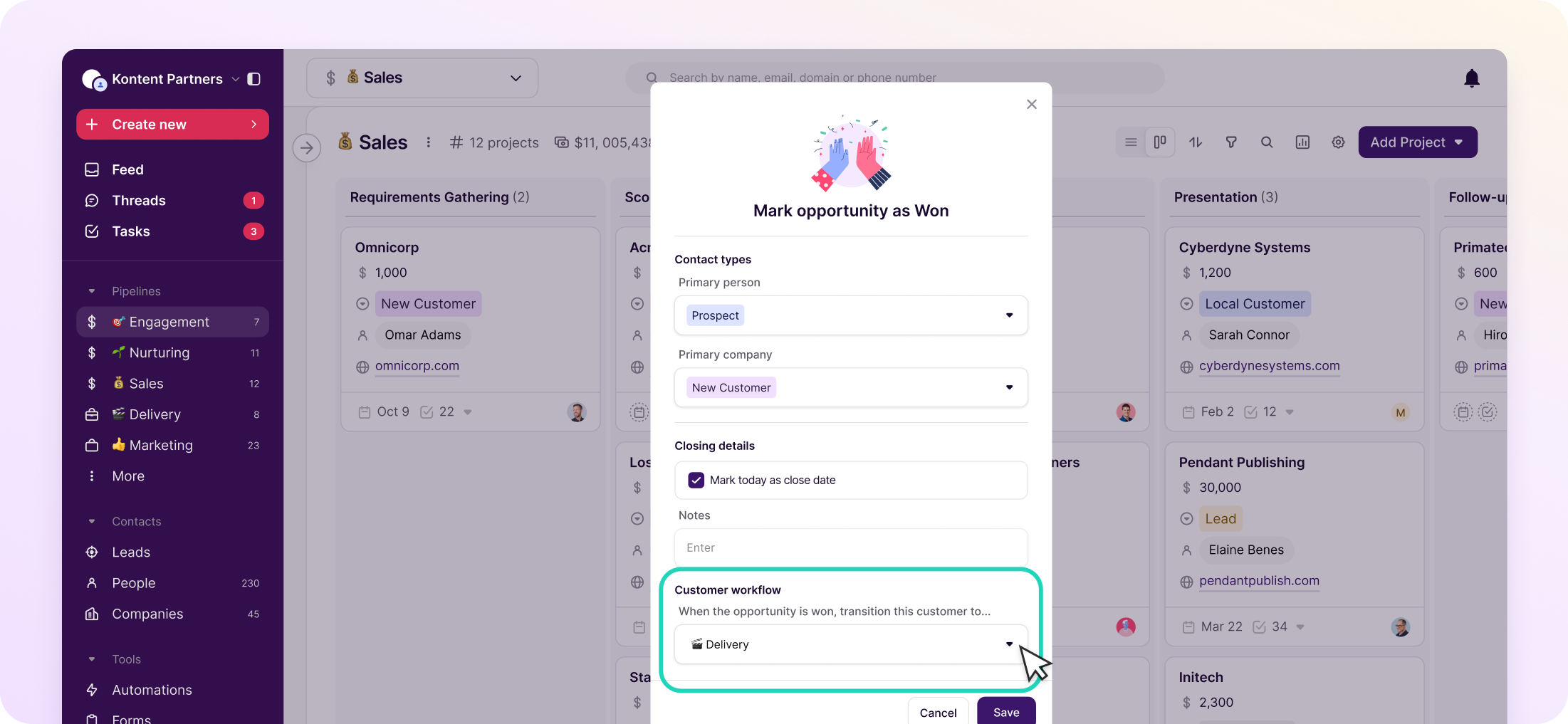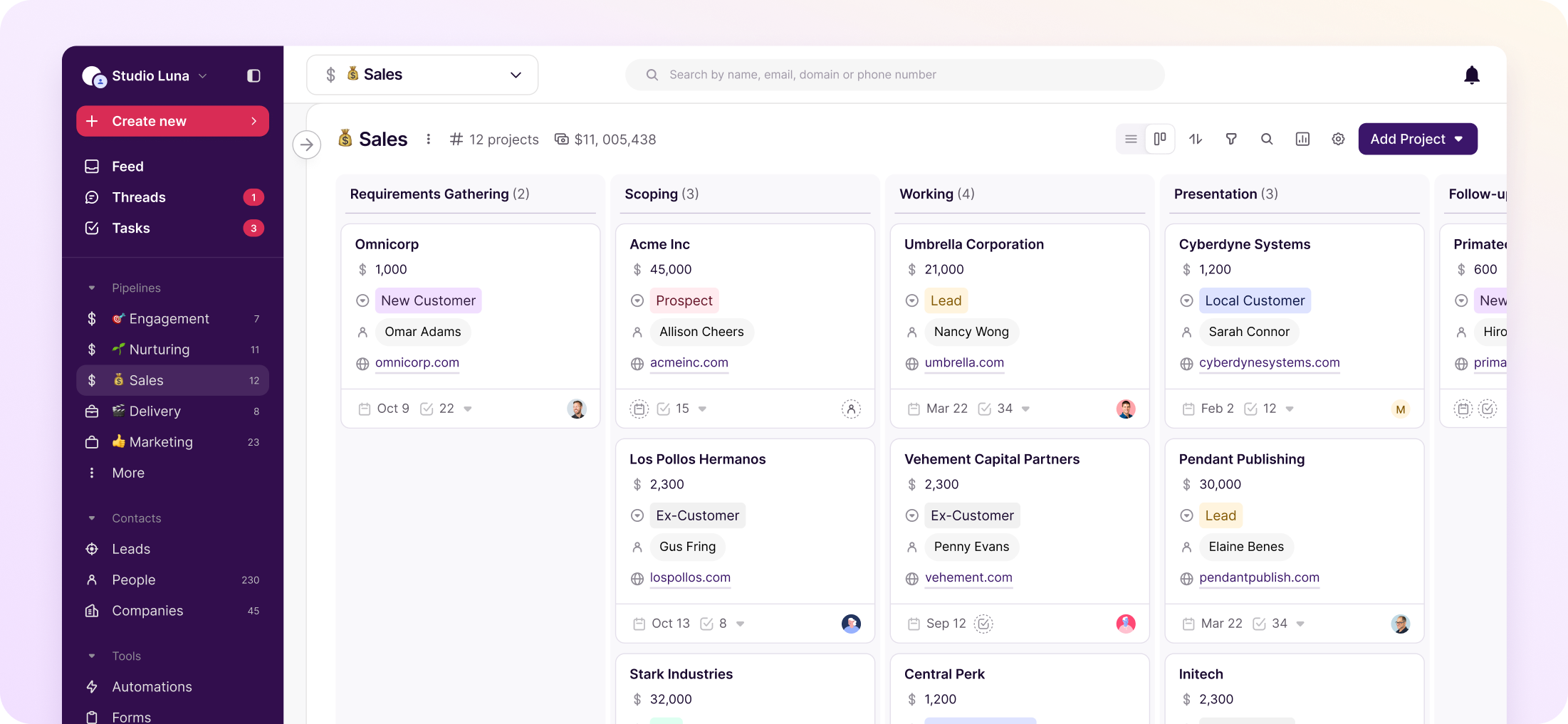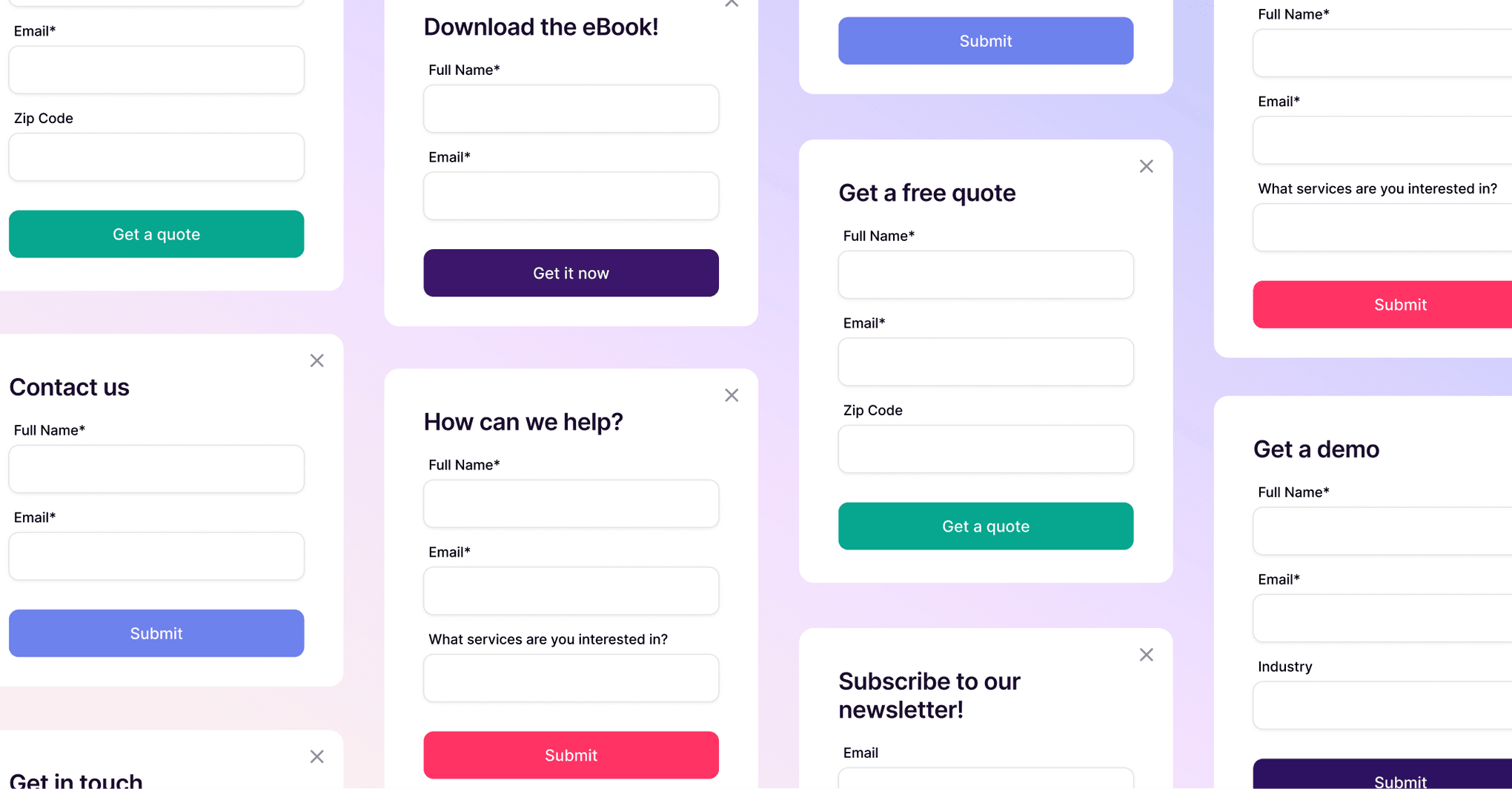Jemicah Marasigan
Content Marketing Manager
You know the moment: the deal is finally closed, the client’s excited, your sales team is riding the high—and then delivery steps in and says, “Wait, what exactly did we promise them?”
There’s confusion over scope, uncertainty about ownership, and a whole lot of “we’ll figure it out later.”
But, this isn’t about finger-pointing. It’s about the fact that the handoff between sales and project management, the step from selling the work to the person doing the work, is often too… vague with missing details.
Notes live in someone’s head, responsibilities aren’t clearly assigned, and important context gets lost between tools, emails, or buried within Slack channels and chats.
Sales moves fast, focused on building momentum. Delivery needs clarity to execute. And when those two sides don’t connect properly, it doesn’t just slow things down—it puts the whole client experience at risk.
If your business has you managing both sales and delivery teams, you’ve probably seen this play out more than once. The frustrating part? It’s not because your people aren’t doing great work — it’s because the connection between the two sides is missing.
And without that connection, the client journey breaks down.
The good news? When sales and delivery are aligned, outcomes improve across the board. Companies with tighter coordination between these functions see up to 36% better customer retention and 38% higher win rates.
But to make that alignment stick, you need more than good intentions and a few shared docs. You need systems that make collaboration easy, context visible, and follow-through second nature.
That’s why more teams are searching for a customer relationship management (CRM) platform that goes beyond just tracking deals.
And that’s exactly why a CRM built specifically for sales and project management matters. It’s about keeping your sales and delivery teams connected, your clients in the loop, and your business running without the guesswork.
What your sales team can learn from your project managers
If your sales and project teams feel a bit disconnected, you’re definitely not alone, it happens all the time.
Salespeople are naturally great at building relationships and bringing excitement, while project managers are pros at organizing, planning, and keeping everyone on track. So, what happens when you combine these strengths? Magic, honestly.
Here’s how your sales team can adopt some of that helpful PM structure to make everything run smoother:
1. Make sure to structure your processes
Ever had a lead go silent on your team, even though the conversation was going great? Chances are it wasn't interest that fizzled: just a follow-up that fell through the cracks.
PMs are built for this stuff. They thrive on workflows, templates, and step-by-step execution. Adding even a bit of that structure to your team’s sales flow — like automated tasks, checklists, follow-up reminders — can keep your team’s momentum strong.
It’s not about being rigid. It’s about giving your sales team less to scramble over. And it’s why more small businesses are looking for a CRM for project management that makes this kind of structure easy to build.
2. Be clear on who owns what part of the process
One thing your project managers really nail? Making it crystal clear who's doing what. No guessing, no crossed wires, just clean handoffs. If your sales folks could borrow that trick—especially when handing clients over to your project team—life would get a lot easier.
Think of it this way: your sales team should always be asking themselves when handing the leads off to the PMs:
What exactly was promised to the client?
What’s already rolling? Don't reinvent the wheel.
What's missing detail-wise? No vague handoffs.
Who specifically is responsible for each piece now?
Having them provide a quick handoff checklist like this upfront keeps things smooth. Your delivery team will thank you, your clients will stay happy, and you won't wake up at 3 a.m. panicking about whether something fell through the cracks.
3. Make sure sales and delivery are on the same page
Sales teams love to say "yes" to everything, and fast. It's understandable: winning business feels great!
But sometimes they can get a little carried away and promise things your project folks simply can't deliver without pulling out their hair.
So here's the move: before your sales team commits to something, make them pause. Take a quick glance at your team’s calendar (your full-time hires and freelancers) and current workload. Who's slammed already? Who has breathing room? Be upfront about timelines with clients from the start.
Realistic expectations keep everyone sane and turn one-off projects into repeat business. It’s a win-win: clients stay happy, your team stays sane, and you can actually enjoy celebrating the deals you close.
You don’t have to turn down great opportunities, but you can shape them in a way that works for everyone. Be honest about timelines. Let clients know when you can deliver your best work.
Clients will respect the transparency, and you’ll be in a better spot to deliver well — and turn those one-off wins into long-term retainers.
Get the latest from our blog every month
What your delivery teams can learn from sales
Now let’s flip it. When your project team is deep in the work — tracking timelines, checking off tasks, managing deliverables — it’s easy to get tunnel vision. But without the human side, even the best-run projects can feel cold or transactional. That’s where your sales team brings value beyond the handoff.
Sales knows how to build connections. They know how to make clients feel seen, heard, and excited. And that energy shouldn’t stop once the contract is signed.
Here’s how your project team can carry some of that same mindset into delivery:
1. Start with the customer, not just the checklist
Sales is all about putting the customer’s needs front and center. That mindset shouldn’t stop at the handoff, it should carry through every phase of delivery.
When a client changes course mid-project (it happens!), don’t have your project team just update the task list or adjust the timeline. Make them pause and revisit the why. Make sure everyone (your team, your tools, and your plan) is aligned with what the client really wants to achieve, not just what’s in the original scope.
As our VP of Customer Success, Perri, shared on The Happy Clients Podcast: “We can't be so quick to pivot into the deliverables. We always want to bring it back to the why behind the work that we're doing on the delivery side.”
It’s a small mindset shift, but it’s a great reminder that a CRM for project management shouldn’t just track tasks. It should help you stay in tune with client goals throughout the journey.
2. Flexibility is better than the perfect plan
Plans are great. But things change. One of the best habits your PMs can pick up from sales? Rolling with it.
Their project plan doesn’t have to be rigid to be effective. Have them make sure to build in buffer time, expect the unexpected, and stay ready to pivot. Also make sure they treat timelines as flexible guides, not hard rules.
If you and your team are using the best CRM for project management (hint: it’s Copper), it should help you all see changes in real time, adjust timelines easily, and keep everyone on the wider team in the loop. That way everyone stays nimble and your clients feel cared for, even when plans evolve.
3. Keep the energy (and comms) going
Sales thrives on regular touchpoints. Delivery should too.
One of the biggest mistakes? Going quiet the moment the contract is signed. That initial excitement can fade fast if clients feel like they’ve been handed off and forgotten. Instead, make sure your PMs keep the energy going. Have them check in before they check you. Have them share progress updates, even if it’s just a quick note to say, “We’re on it.”
Clients don’t just care about outcomes: they care about feeling seen, included, and in the loop. And when you're juggling delivery work, admin, and everything else, those small moments of connection can be easy to forget.
This is where the best CRM for project management makes all the difference. With tools like automated emails, reminders, and timeline tracking, your project managers can keep communication flowing without dropping the ball. It helps your team stay thoughtful and proactive, even when they're deep in the weeds.
The best CRM for project management connects every step from deal to delivery
At this point, you already know the most painful point in the client journey: the space between "we closed the deal" and "we kicked off the project."
That handoff often breaks down, not because your team isn’t capable, but because your tools don’t support how your teams actually work together.
You don’t need five tools duct-taped together. You need one system where your sales and delivery teams can stay aligned, share context, and keep momentum going.
A CRM for project management should do just that: connect the dots from first outreach to final deliverable.
That’s why more and more people are asking: “What’s the best CRM and project management tool for small businesses that actually fits the way we work?”
More often than not, they’re finding their way to Copper because it’s built to support the full customer journey (from the first call to project delivery), in one place, and help you deliver with the same care you bring to every relationship.
That’s exactly how Kontent Partners uses it. Once a deal is marked “Won,” it moves straight into a “Delivery” pipeline in Copper, where they manage everything from budgets and timelines to who’s doing what—whether it’s a freelancer or an internal team member.

“Copper’s real superpower for us is connection,” says McKenna Turner, Kontent Partner’s Head of Production.
“We were pitched Copper for sales, but after going through the tutorial it was clear that we could use it to connect engagement, bidding and active project management, creating a full-circle system. It’s not just a sales platform. It’s a detailed map of our business.”
That shift (from scattered tools to a single source of truth) has been a game-changer for their team.
And if you’ve ever felt the friction between closing a deal and actually delivering the work? You’re not alone. Copper helps you smooth that gap, keep everyone aligned, and deliver on the promises your clients signed up for.
Why Copper is the CRM for project management small businesses actually need
Here’s the thing we kept noticing: a huge number of Copper customers weren’t just using us for sales. They were setting up onboarding pipelines. Managing client work. Tracking delivery tasks right inside the CRM.
Because the relationship doesn’t end when the deal is closed and the tools you use shouldn’t either.
That’s why we built project management right into Copper. Not as an afterthought, but as a real part of your workflow. With Copper, you can:
Launch onboarding or delivery Pipelines in seconds
Break work into manageable steps with tasks and subtasks
Use templates to kick off repeatable projects with ease
Let multiple teammates own what they need to — without the back-and-forth
Tie it all back to the original deal, so the full story lives in one place

And everything syncs in real-time, so updates feel effortless. Whether your team is managing one-off projects, monthly retainers, or long-term strategic work, Copper helps you all stay in control and keep that client magic alive.
If you’ve been wondering whether there’s a CRM and project management solution out there for small businesses like yours — one that’s built with your teams’ workflows in mind — Copper’s probably what you’ve been looking for.
Ready to connect your sales and delivery workflows?
When a deal closes, your project team shouldn't have to play catch-up.
The key to delivering a smooth client experience is making sure your post-sale workflows are just as well thought out as your sales process.
That means creating a clear bridge between the people who sell the work and the people who deliver it—without relying on more meetings, duct-taped tools, or crossed fingers. Here’s how to start building that bridge inside your CRM:
Build a pipeline that picks up where sales leaves off. Create separate pipelines for onboarding, implementation, or client success. Assign multiple record owners so sales and delivery teams can stay aligned and informed as the project moves forward. Everyone can follow progress, add notes, and jump in. Make it clear what happens after the deal closes—and who’s owning what.
Turn your task list into a well-oiled delivery machine. If your sales team is already using tasks to follow up with leads, apply that same structure for your PMs who handle onboarding and delivery. Track milestones, approvals, and client check-ins using tasks and subtasks.
On that note, collaborate with your team with ease. For each task, assign task owners, set due dates, and add notes to keep everyone on the same page. Want to pull someone in quickly? Use @mentions in task comments to notify teammates in real time.
Nail your team’s handoffs like a pro. Create a quick, repeatable checklist for every new deal that goes into onboarding. What was promised? What’s already in motion? What does delivery need to know to get started without missing a beat? You can even do automated task creation when a deal hits “Won,” so your onboarding process is already in motion by the time delivery steps in.
When your CRM and project management live in the same place, everything just clicks. Your teams will spend less time scrambling and more time delivering the kind of experience that keeps clients coming back.
The baton pass matters more than you think
Closing the deal is just step one. What really defines the client experience (and whether they stick around) is what happens next.
As someone managing both sides of the house, you’ve seen how easily things can fall through the cracks if your sales team and delivery team aren’t in sync. That’s why having one connected system matters. Not just to keep everyone organized, but to make sure nothing gets lost in translation.
Because your clients don’t see your departments or workflows. They just see the results and the communication. And when everything’s in sync (when sales, onboarding, and delivery are all working together) that experience feels seamless.
If you’ve been looking for the best CRM for project management, one that fits the way small teams actually work, you’re in the right place. Copper is built to help you manage both sales and delivery in one place—no switching tabs, no dropped balls, no burnout.
Try Copper free for 14 days and see why it’s the CRM and project management solution for small businesses that’s built for the full journey, from “Let’s do this” to “We’re done (and they’re thrilled)!”






